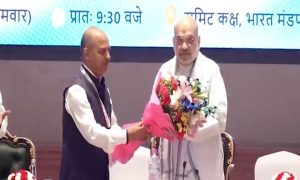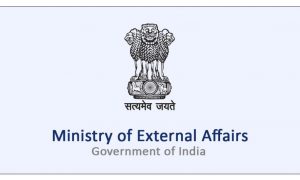Indo China Relations. Both gain – neither lose!

Baskaran Krishnamurthy
India has a definite edge over China in the bilateral relations. Where does this ‘advantage’ come from? Is it a political or economic benefit? It is both.
Every single step of growth would make India mightier and would take it closer to China. India with a population of more than 1200 millions has to find ways to expand its areas of economic activities. America, China, Russia and the European Union are the ones that can accommodate our demands and desires to our expectations.
Leaving the border issues aside, we have to move ahead with a stable economic co-operation with China. This would facilitate a massive inflow of funds and also create thousands of new jobs in various spheres. China is so close to us geographically and so identical with many of our ancient customs and culture and so is easily the best bet to look forward to enlarge our operations beyond our own territories.
The India-China bilateral trade reached $84.44 billion in 2017 reports PTI. India exported Iron ore, organic chemicals, cotton yarn and diamonds along with copper.
Since it has a larger populace than us, China may not absorb as many people from India in its employment market as the U.S.A. Yet, the exports have generated a number of jobs in India and have resulted in improved economic conditions of those who work in these fields
Any improvement in relations that in turn increases the volume of exports is too good for indigenous market. That said, there is another benefit too which is indirect and not so easily perceivable.
Improved economic relations bring with it a bond between the trading communities of the two countries and this helps in reducing the possibility of any armed conflict of grave consequences. Economic ties are the healthiest way to keep the peoples of two nations strongly attached to each other.
When the tensions ease and when the relations become much more ‘reliable’, the defence budget gets eased too and would allow huge funds to be diverted to more constructive schemes that would benefit the common man at large. A marked improvement in relations with a stronger neighbour is the most welcome development for any nation. This way, India stands to gain too.
During the past 10 years or so, bilateral trade between India and China keeps surging and an increasing level of business engagements would directly result in decelerating the growing tensions at the border areas. The relations saw a remarkable improvement with an ‘outward looking’ approach when A B Vajpayee visited China in 2003. This friendly gesture of the Indian statesman instantly triggered a series of bilateral discussions at various levels of governance that in turn set in motion, the process of a more serious economic co-operation between the two.
As the ‘Business Standard’ reported in 2009 – ‘since 2009, trade between China and India has grown nearly twice as fast as each country’s trade with the rest of the world, and since 2001, China’s trade with India has grown more rapidly than its trade with any of its top 10 trade partners. In 2008, China surpassed the United States to become India’s largest trade partner. Last year, India was China’s tenth largest export market.’
While in a trade agreement normally both parties stand to gain, India would hopefully reap larger benefits as is the normal practice in bilateral trade agreements – the weaker of the two countries would be benefited more.
The Chinese economy has almost reached appoint of saturation with a very limited scope of expanding its operations beyond already explored areas whereas Indian economy enjoys a free run capable of accommodating more and more of new ventures and new trade partners.
To quote the Business Standard again, ‘Imports of lower-priced capital goods from China, such as turbines for electric utilities, can help India address the infrastructure bottlenecks—especially in roads, highways, ports, and electric power—that have appeared as India’s manufacturing revolution gets under way. Because Chinese capital goods are often much cheaper than those from Western or Japanese manufacturers, such imports from China can keep costs low, allowing India to modernize and upgrade its infrastructure more quickly.
A second possibility is that Chinese capital could help India accelerate its infrastructure revolution. China has an abundance of capital looking for attractive investment opportunities. Over the next 10 years, India’s infrastructure projects will provide perhaps one of the largest such opportunities’. (unquote)
These observations of the China Business Standard do not quite reflect the entire scenario because this was written long before the Doklam stand-off. The Chinese authorities time and again raise the issue of border demarcation and South China Sea and our growing relations with the U.S. and Japan also do not go well down with them.
The centuries old traditional, cultural, natural relations must be allowed to overtake the recently ‘created’ distrust and suspicion between us. It requires a strong political will from the leaders of both the countries to go past the unpleasant happenings and to keep the fringe elements at distance to forge a long lasting, meaningful relationship.
Ideologically, India and China can never be identical and can never go hand in hand with China sticking to its repressive Communist regime and India struggling to retain its Gandhian image. But China’s urge to become the numero uno and India’s necessity to deliver much more to the needy millions should be enough to force leaders of both to come to terms with the reality on ground.
All the talks about the two fastest growing economies of the world would be of no use and would serve no purpose unless we are able to sustain the momentum for the next few decades. The growth rate may keep fluctuating and it might be 7+ in a year and slow down to even 4 or 3. It does not matter so much so long as there is a ‘growth’ and the ‘rate’ is manageable since the growth rate is more of comparison than absolute.
But, even a slight downslide in a year resulting in a negative growth could be dangerous since it would drag the Indian economy back to ‘uneasy’ situations. And, it would take many more years of sustained, vigorous efforts to keep it back on the trajectory of a stable, significant growth.
India has to do everything at its command to keep its ambitious plan of becoming the no 3 of World economy. To achieve it, we need to have a much bigger, much broader trade relations with the ‘bigger’ and ‘broader’ economies of the world – the U. S. and China.
Delightfully, the leaders of both the countries seem to have realized the importance of smoother relations between the two and as has been described by both, there IS a perceptible change in the mindset of the authorities from either side. It seems that the ‘Indi – China bhai bhai’ days are truly arriving – to the betterment of the whole region. Let us hope for the best.
What about – India – and the Arabs?
Author – Baskaran Krishnamurthy, Writer, Columnist & Income Tax officer




























 WhatsApp us
WhatsApp us